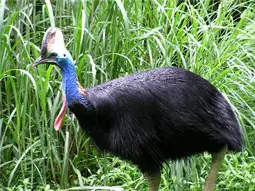 The cassowary belongs to the genus Casuarius and is very large flightless bird found in the native to the tropical forests northeastern Australia and New Guinea. Some nearby islands also have small populations, but it is not known if these are natural or the result of the New Guinea trade in young birds. They mainly eat fallen fruit or fruit on low branches. They also eat fungi, snails, insects, frogs, snakes and other small animals.
The cassowary belongs to the genus Casuarius and is very large flightless bird found in the native to the tropical forests northeastern Australia and New Guinea. Some nearby islands also have small populations, but it is not known if these are natural or the result of the New Guinea trade in young birds. They mainly eat fallen fruit or fruit on low branches. They also eat fungi, snails, insects, frogs, snakes and other small animals.
Cassowaries (from the Indonesian name kasuari) are part of the ratite group, which also includes the emu, rhea, ostrich, moa (now extinct), and kiwi. There are three species recognized today:
• Southern Cassowary or Double-wattled cassowary C. casuarius of Australia and New Guinea.
• Dwarf Cassowary C. bennetti of New Guinea and New Britain.
• Northern Cassowary C. unappendiculatus of New Guinea. Of three species of cassowaries in the world, only the southern cassowary, Casuarius casuarius johnsonii, is found in Australia.
Like the emu and ostrich, the southern cassowary is a ratite, a large flightless bird with unusual feathers and other features that distinguish it from all other birds.
The bird has no tail, and its wing stubs carry a small number of long, modified quills, like rounded fingernails, which curve around the body. Each heavy, well-muscled leg has three toes, with the inside toe bearing a large dagger-shaped claw that can be used in defence. When the bird is cornered or protecting chicks, it kicks out with both feet at once, and can injure, or even kill, dogs or humans. More usually, it dashes off when alarmed, head lowered, casque first, through the heavy undergrowth. It reaches 40 kilometres per hour in short sprints and can even swim.
 Adults can grow to an imposing 2m tall. In general, the sexes are fairly similar in appearance, though females are slightly larger and can weigh up to 75kg. Males can weigh up to 50kg. The striking bird has a glossy black plumage, and the adult southern cassowary has a tall, brown casque (helmet) on top of its head, a vivid blue neck and long drooping red wattles. The purpose of the casque is unknown but it may indicate dominance and age, as it continues to grow throughout life. Recent research indicates it may also assist cassowaries in “hearing” the low vibrating sound made by other cassowaries.
Adults can grow to an imposing 2m tall. In general, the sexes are fairly similar in appearance, though females are slightly larger and can weigh up to 75kg. Males can weigh up to 50kg. The striking bird has a glossy black plumage, and the adult southern cassowary has a tall, brown casque (helmet) on top of its head, a vivid blue neck and long drooping red wattles. The purpose of the casque is unknown but it may indicate dominance and age, as it continues to grow throughout life. Recent research indicates it may also assist cassowaries in “hearing” the low vibrating sound made by other cassowaries.
The topical rain forests inhabited by this bird would be very different places with diminished diversity if they become extinct. These huge birds are the only animals capable of distributing the seeds of more than 70 species of trees whose fruit is too large for any other forest dwelling animal to eat and relocate. If these trees did not have an animal to disperse their seeds, they would only occur in concentrated pockets around the parent tree or in places where the seeds rolled such as gullies or the bottom of slopes. As a result the structure of large tracts of forest is likely to change. In tropical rain forests in other parts of the world there are a wide range of animals which fulfil this role. In the Wet Tropics of Australia the cassowary plays the role which is accomplished by entire guilds of animals elsewhere.

The outlook for this extraordinary bird is pretty grim: there are approximately only 40 adults (only 17 breeding females) 28 sub adults, and 31 chicks roaming the forests of Mission Beach in far north Queensland. There only about 900 cassowaries remaining in the Wet Tropics, fewer than the panda in China and the tiger in India. The Australian Rainforest Foundation has taken over the rehabilitation centre at Mission Beach. In the Mission Beach area alone, Cassowaries have lost about 50% of their critical habitat in the past ten years due to development. On top of this, cyclone Larry’s 240 kilometre (150mph) winds devastated the area in March 2006, destroying much of their feeding grounds. As a result the Cassowaries are starving.
A number of factors affect the survival of this bird. The major threats include the loss, fragmentation and modification of habitat, vehicle strikes, dog attacks, human interactions, pigs, disease and cyclones. However, the increasing ferocity and frequency of cyclones could be the last straw, pushing this magnificent bird into extinction. Professor Steve Turton, from the Australian Tropical Forest Institute at James Cook University is convinced that, “…we are going to get more of these severe tropical cyclones, simply because there’s just going to be more energy in the systems”.
Page updated 6 June 2010
|
Other Species Impacted Upon by Climate Change
Quiver Tree |
